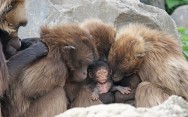This last week, the world has been in mourning for Koko the beloved mountain gorilla who learned to speak in American sign language. Koko was born on the 4th of July 1971, hence her name “Fireworks-child” (in Japanese), shortened to “Koko.” This fireworks child was a prodigy – she learned to play the recorder, and to sign over 1,000 signs and understand 2,000 words of spoken English. Koko was sad when she lost a pet, spoke about her longing for a child (the pet kitten was a close substitute) and talked about death and her own death. She also played with words and mixed them up in new combinations. She once described herself as a “fine-gorilla-person.”
Did humans teach Koko about language, or did Koko teach humans? Koko could speak in sign language,
but also more importantly, she could listen. When she listened, she interpreted things in her own way.
Despite criticism of the Koko project (which stated that Koko was mimicking her trainers), Koko
responded in unexpected ways. When she was asked where gorillas go to when they die, she said
“comfortable-hole-bye.” There were a few occasions when she expressed deep sadness and grief, like
when her pet kitten was hit by a car and killed.
Language is often used as an excuse to elevate humans above other animals. There were scientists who
felt Koko’s use of language was meaningless, as she didn’t learn grammar and syntax. But throughout
her life, Koko used sign language not as a lifeless toy or tool to get food and water, but a way to
communicate and describe her world. Communication –- rather than language –- was the key. Koko
and her researchers built a rapport together, where words could mean more than the dictionary
definition, they could mean complex emotional states and refer to shared understanding between
Koko and the researchers. Above all, what Koko taught us is that language is a human invention, but
communication is common to all animals. For that, we owe a debt to Koko, our Gorilla teacher.








Social Media